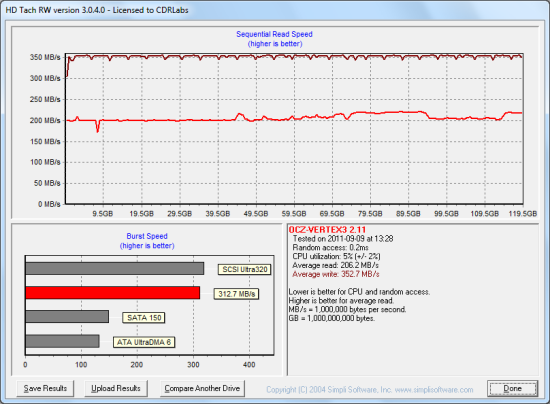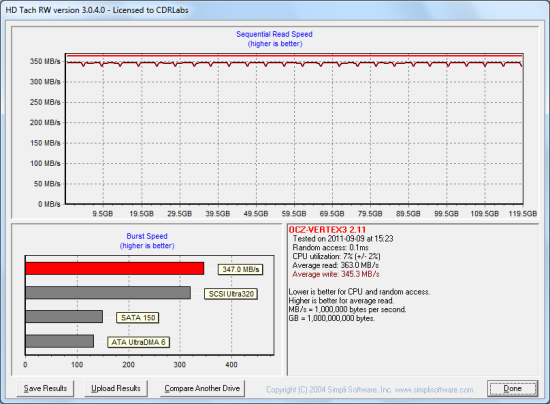TRIM Performance:
While SSDs offer many benefits, there are some downsides to using flash memory. One of the biggest issues people run into is performance degradation. Over time, an SSD will run out of fresh blocks and will have to write over data the file system has marked as deleted. This procedure is very complicated and can slow an SSD's write speeds considerably.
To address this problem, most manufacturers have added TRIM support to their SSDs. The TRIM command allows an operating system, such as Windows 7, to tell an SSD which data blocks are no longer in use. Using this information, the drive pro-actively erases these blocks and adds them to the free block pool.

To test the Vertex 3's TRIM function, I first put the drive in a "dirty" state. I used Iometer to fill the entire drive and then ran a random write test for 20 minutes. Surprisingly, this had very little effect on the Vertex 3's write speed. However, its average read speed dropped to 206.2 MB/s.

OCZ Vertex 3 - Dirty
To see how well the Vertex 3 could recover, I let the computer sit for a few hours and then reran the test. The drive wasn't able to reach the factory fresh performance shown in our earlier tests, as its average read speed climbed up to 291.4 MB/s.

OCZ Vertex 3 - After Trim
Lastly, I used OCZ's Toolbox utility to perform a secure erase on the Vertex 3. With the drive wiped clean, its read speed jumped back up to 363.0 MB/s.

OCZ Vertex 3 - Wiped
Final Thoughts:
OCZ's 120GB Vertex 3 is an excellent choice for anyone looking to put a high-performance SSD in their desktop or laptop. Thanks to its SandForce SF-2281 controller and SATA 6Gb/s interface, the drive performed very well in our sequential read and write tests, reading at speeds as high as 558 MB/s and writing at speeds in excess of 460 MB/s. The Vertex 3 also took the top spot in our random write tests, delivering more than 66,000 IOPS. As with other SandForce drives, the Vertex 3's performance did take a hit when reading and writing incompressible data. However, with its synchronous NAND flash, it was still faster than its sibling, the Agility 3.
The price of the 120GB Vertex 3 has come down considerably since it was introduced. It currently goes for $200 on Amazon.com, which is only $35 more than the Agility 3. With a price gap this small, the 120GB Vertex 3 is definitely the better bang for your buck. The price of the 240GB Vertex 3 has also come down some over the last few months. However, with prices starting at $460, it is still at least $100 more than the 240GB Agility 3. This may push more budget conscious consumers towards the Agility 3, but if you have the room in your computer, a pair of 120GB Vertex 3's would probably be a better choice.

Highs:
- Available in 60GB, 120GB and 240GB capacities
- Excellent sequential read and write speeds
- SATA 6Gb/s interface
- Synchronous NAND flash
- Supports TRIM, SMART and NCQ
- Includes a 2.5" to 3.5" adapter bracket
- 3 year warranty
- 60GB and 120GB versions are reasonably priced
Lows:
- Not as fast when writing incompressible data
- 240GB version is still pricey

